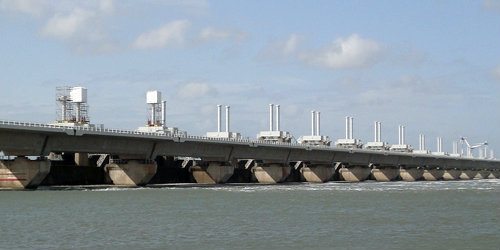Stress measurement
Faculty of Engineering researchers and their spin-out company Veqter have developed a unique service that measures hidden stresses inside mission-critical industrial components.
More than a decade of research into a new technique for checking the residual stresses locked inside manufactured parts is helping to extend the useful lifetime of the UK’s nuclear power stations and ensure structural integrity of critical components used in aerospace applications.
To ensure the structural integrity of key industrial components it is essential to understand all of the stresses and strains that they are put under.
Some of the forces that they must withstand are self-evident – for example the loads on turbine fan blades in aircraft engines as they spin, or on the metal chains of a suspension bridge. But there is another, hidden, factor that is just as important, and much more difficult to measure.
'Residual stress' has been a longstanding research subject for Professors David Smith and Christopher Truman in Bristol’s Solid Mechanics Group, leading to a successful spin-out company and a unique industrial tool.
Residual stress is the term used to describe the mechanical forces that are locked up in a component when it is first made, repaired or its properties change during service.
Standard manufacturing techniques like shaping, welding or plating of steel all introduce different kinds of stresses.
When combined with the forces applied during perhaps millions of load cycles over a part’s lifetime, residual stress can lead to unexpected and catastrophic failure of a component, and sometimes an entire structure.
In 1967 the Silver Bridge over the Ohio River collapsed under rush-hour traffic, killing 46 people.
An investigation found the root cause to be the failure of a single link, just below one of the suspension bridge’s towers, with residual stress thought to be a contributing factor. More recently, the 1998 derailment of a high-speed train in Enschede – Germany’s worst rail disaster – was traced back to a single fatigue crack in a wheel of the train.
The trouble with residual stress is that it is extremely difficult to measure, particularly when it comes to manufactured parts that are more than ten centimetres thick.
The semi-destructive technique developed by the Bristol engineers has formed the basis for the successful spin-out company Veqter, whose managing director Ed Kingston was a research associate in the Solid Mechanics Group.
The technique is unique in its ability to analyse such large sections on-site. That is simply impossible with non-destructive alternatives like neutron diffraction – a technology that requires a dedicated laboratory, is hugely expensive, and only works to a depth of a few centimetres.
The method established by Smith and Truman and offered by Veqter relies on deep-hole drilling.
It involves removing a cylinder of material from the component being analysed (hence the “semi-destructive” description), and measuring any changes in the diameter of a narrow, pre-drilled reference hole.
Using algorithms developed over years of research, that information can be translated to indicate the residual stresses in the component. As the only company worldwide to offer this facility as a service, the spin-out has established an impressive list of blue-chip clients in the heavy engineering sector. They include the aerospace giants Airbus and Rolls-Royce, while Siemens has used Veqter to analyse stresses in a steel turbine to a depth of 75 centimetres.
Veqter’s customer base also includes many of the major names in nuclear power.
EDF Energy has used its services to help extend the lifetime of its fleet of gas-cooled nuclear reactors in the UK, while Japan’s Nuclear Energy Safety Organisation has been able to evaluate stress corrosion cracking in the country’s pressurized water reactor plants.
Others to use the deep-hole drilling approach include the US Nuclear Regulatory Commission, which has validated predicted residual stresses inside welded parts of nuclear control rods, and the engineering group AREVA, which has gained crucial insights into its development of advanced welding techniques used to join heavy steel components to stainless steel piping.
More recently the Bristol research team has greatly extended Veqter’s scope by developing ways to measure residual stress in advanced materials such as composites, graphite, plastics and glasses, as well as in welds incorporating different metals.
With the company servicing a global client base since its 2004 incorporation, it appointed a dedicated agent in Japan in 2008, and has grown to employ 9 people and record a turnover of £750K in 2014. As well as the laboratory and on-site analysis services, it has also launched the world’s first residual stress database.
Professor Christopher Truman

